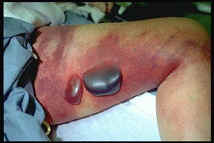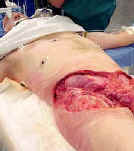 Introduction.
Introduction.
Microbial Diseases A to Z | Disease Home Page | Bio 406 Home Page | MicroWorld |
 Introduction.
Introduction. Necrotizing fasciitis (NF, sometimes called "flesh-eating disease") is a tissue infection by Group-A Streptococcus bacteria, most notably Streptococcus pyogenes. The infection's sometimes rapid progression and dramatic appearance have fueled the media's fascination with any cases. Although the majority of people recover, about 10 - 15% of infected persons will die from NF. Nonetheless, there are only ~ 600 cases of NF in the US annually.
Streptococcus pyogenes is a Gram-positive, round bacterium that usually forms chains of cells. Found in the respiratory tract of many people, it is known to cause a variety of infections leading to diseases such as Strep Throat, scarlet fever, and impetigo.
Infection of the subcutaneous tissue leads to inflammation with redness and pain, followed by tissue death (necrosis) accompanied by swelling/bloating of tissue due to gas buildup. NF destroys muscle, skin and adipose tissue. Complications include a rapid drop of blood pressure that may lead to death in 10 - 15% of patients.
Group-A Streptococci can be identified using rapid antibody tests or, more traditionally, blood agar plates.
 Treatment
TreatmentAntibiotic treatment (e.g. Penicillin) is often successful, but surgical removal of infected tissue (called debridement, see photo right) may be necessary.